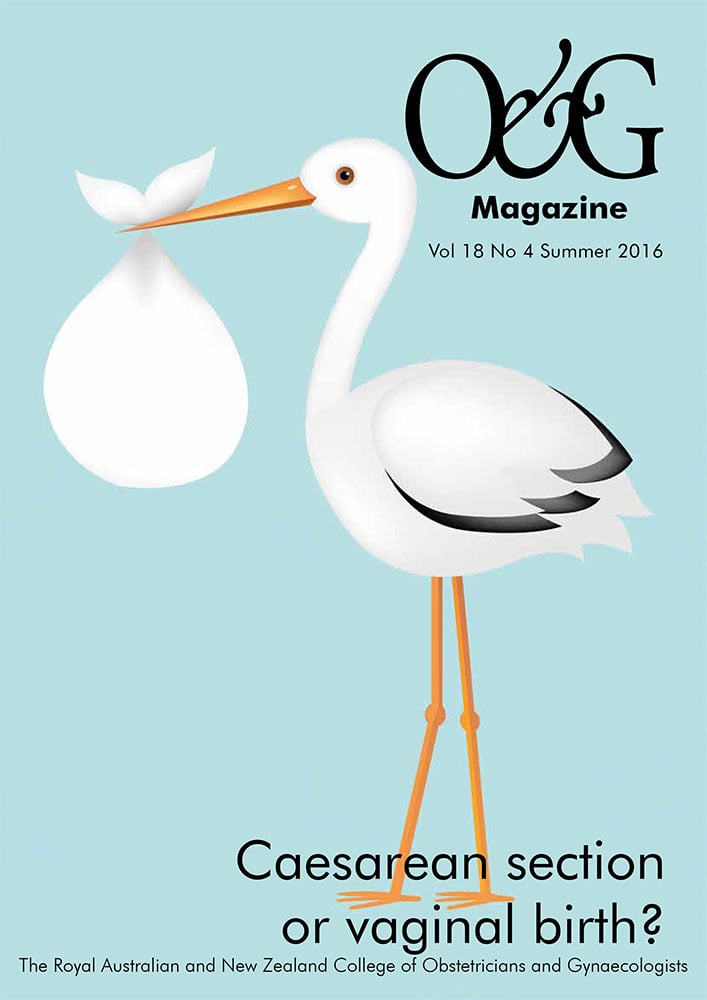‘A 22-year-old nulliparous woman presents to your hospital with ruptured membranes for 12 hours at 39+5 gestation, but not in labour. What is the best approach to managing this patient, especially in terms of antibiotics?’
Term prelabour rupture of membranes (PROM) occurs in one in 12 pregnancies. Spontaneous onset of labour and birth is common following PROM, with reported rates of 70 per cent, 85 per cent and 95 per cent at within 24 hours, 48 hours and 96 hours, respectively.1 2
The management of term PROM depends on several factors, including maternal and fetal wellbeing at the time of assessment, maternal choice, fetal presentation, Group B Streptococcus (GBS) status and time since rupture of membranes (ROM). The two main issues upon which decision-making is predicated are:
- the timing of interventions to augment birth
- the use of antibiotics.
Before any management plan is determined, it is important to confirm gestational age, obtain a detailed history and perform a thorough examination, including a low vaginal swab in those women who have not had routine antenatal screening.
Membrane rupture can be confirmed by careful history taking and bedside examination, including inspection of any pads or fluid that can be seen. The presence of blood or meconium should be noted. If the diagnosis is uncertain, then sterile speculum examination and testing for amniotic fluid in the vaginal vault with point-of-care testing such as nitrazine (Amnicator), placental alpha-microglobulin 1 protein (Amnisure) testing or microscopic analysis should be performed. At that time, swabs for culture can be taken.
Fetal wellbeing should be assessed with auscultation of the fetal heart rate and recording of fetal movements. In addition, fetal presentation should be determined with particular regard to engagement of the presenting part. Signs of fetal distress or clinical chorioamnionitis should prompt urgent delivery.
If the fetus is in a cephalic presentation, recent RANZCOG guidelines recommend offering active management of term PROM based on a reduction in chorioamnionitis and endometritis and increase in satisfaction among mothers with induction of labour (IOL).3 4 5 The optimum timing of IOL is debated and there is variety in practice worldwide. National Institute for Health and Care Excellence (NICE) guidelines suggest IOL at 24 hours after ROM6 and ACOG guidelines recommend that if labour does not commence at the time of presentation, then it should be induced.7 Maternal preference must also be taken into consideration as this is part of the shared decision-making process.
Expectant management is appropriate in a subset of women presenting with term PROM. RANZCOG sets out criteria for when it can be considered a safe option. Expectant management can occur at home or in a hospital setting and is dictated primarily by the ability to provide good monitoring, support for the woman and maternal wishes.8
There is clear guidance that in the case of GBS colonisation antibiotics should be commenced.9 There is less clear consensus for the administration of prophylactic antibiotics in women without proven GBS. It has been shown that as time passes from the ROM, the risk of chorioamnionitis and endomyometritis increases10 as does neonatal septicaemia.11 Morbidity due to chorioamnionitis increases significantly after 12 hours since ROM.12
The current RANZCOG statement acknowledges that there ‘appears to be a reduced risk of maternal infectious morbidity’ with antibiotic use, but does not make a clear recommendation for administration. This is largely based on a 2002 Cochrane review of two trials that compared the outcomes of antibiotics given with IOL 12 or more hours after PROM.13
The most recent Cochrane Database Systematic Review (2014) recommends against the routine administration of prophylactic antibiotics.14 The change in recommendation from the 2002 review comes from inclusion of two more recent randomised trials.
A more recent meta-analysis of five randomised trials in a secondary subgroup analysis suggested a significant decrease in rates of chorioamnionitis and endometritis in women with 12 hours or greater or ruptured membranes if treated with antibiotics.15 Such a policy needs to be balanced with public health concerns regarding the widespread overuse of antibiotics.
In this case, a primigravid woman who has had ruptured membranes for 12 hours, with no risk factors, an appropriate management plan would be to offer IOL and withhold antibiotics unless there were clinical signs of infection. Should prophylactic antibiotics be considered, ampicillin would be the most appropriate choice in the absence of any concern around hypersensitivity. Babies born following PROM should be observed appropriately for signs of infection.
References
- Keirse MJ, Ottervanger HP, Smit W. Controversies: prelabor rupture of the membranes at term: the case for expectant management. J Perinat Med. 1996;24(6):563-72.
- Hannah ME, Ohlsson A, Farine D, et al. Induction of labor compared with expectant management for prelabor rupture of the membranes at term. TERMPROM Study Group. N Engl J Med. 1996;334(16):1005-10.
- Hannah ME, Ohlsson A, Farine D, et al. Induction of labor compared with expectant management for prelabor rupture of the membranes at term. TERMPROM Study Group. N Engl J Med. 1996;334(16):1005-10.
- RANZCOG. Term Prelabour Rupture of Membranes (Term PROM). C-Obs 36. 2014.
- Dare MR, Middleton P, Crowther CA, Flenady VJ, Varatharaju B. Planned early birth versus expectant management (waiting) for prelabour rupture of membranes at term (37 weeks or more). Cochrane Database Syst Rev. 2006(1):CD005302.
- National Institute for Health and Care Excellence (NICE). Intrapartum care for healthy women and babies. Clinical guideline [CG190] 2014. Available from: https://www.nice.org.uk/guidance/cg190?u nlid=73920530820161030153128.
- Premature rupture of membranes. Practice Bulletin No. 172. American College of Obstetricians and Gynecologists. Obstet Gynecol 2016; 128:e165–77.
- .RANZCOG. Term Prelabour Rupture of Membranes (Term PROM).C-Obs 36. 2014.
- RANZCOG. Maternal Group B Streptococcus (GBS) in Pregnancy: Screening and Management. C-Obs 19. 2016. Available from: www.ranzcog. edu.au/RANZCOG_SITE/media/RANZCOG-MEDIA/Women%27s%20 Health/Statement%20and%20guidelines/Clinical-Obstetrics/Maternal-Group-B-Streptococcus-in-pregnancy-screening-and-management-(C-Obs-19)-Review-March-2016.pdf?ext=.pdf.
- Tran SH, Cheng YW, et al. Length of rupture of membranes in the setting of premature rupture of membranes at term and infectious maternal morbidity. Am J Obstet Gynecol. 2008;198(6):700 e1-5.
- Herbst A, Kallen K. Time between membrane rupture and delivery and septicemia in term neonates. Obstet Gynecol. 2007;110(3):612-8.
- Tran SH, Cheng YW, et al. Length of rupture of membranes in the setting of premature rupture of membranes at term and infectious maternal morbidity. Am J Obstet Gynecol. 2008;198(6):700 e1-5.
- Flenady V, King J. Antibiotics for prelabour rupture of membranes at or near term. Cochrane Database Syst Rev. 2002(3):CD001807.
- Wojcieszek AM, Stock OM, Flenady V.Antibiotics for prelabour rupture of membranes at or near term. Cochrane Database Syst Rev. 2014(10):CD001807.
- Saccone G, Berghella V. Antibiotic prophylaxis for term or near-term premature rupture of membranes: metaanalysis of randomized trials. Am J Obstet Gynecol. 2015;212(5):627 e1-9.






Leave a Reply